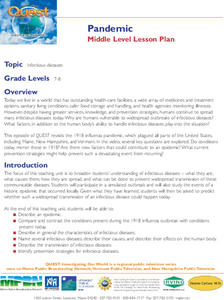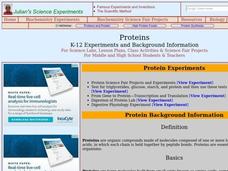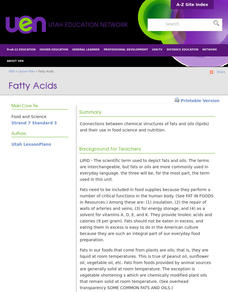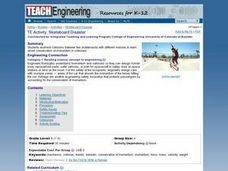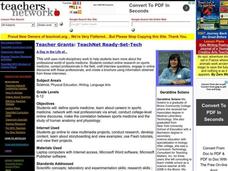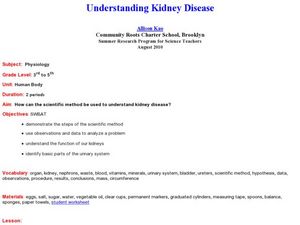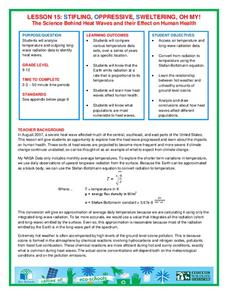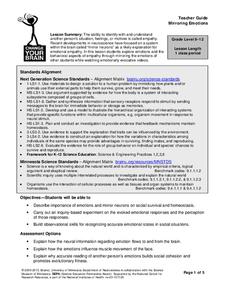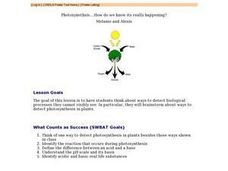Curated OER
Pandemic
Students compare and contrast the conditions of the 1918 influenza outbreak with those of today. They try to identify prevention strategies for infectious diseases.
Curated OER
Sun and Skin
High schoolers work in small groups researching different aspects of the sun and skin. The groups summarize and answer questions about the material in a presentation to the class.
Curated OER
Have a Heart!
Students assume the role of a doctor, detective, and decision maker. They research the function of the heart, the diseases associated with the heart, and lifestyle choices that are heart healthy. Information gathered will be placed in a ...
Curated OER
History of the X-Ray
Seventh graders discuss the history of the x-ray machine. For this social science lesson, 7th graders understand how a x-ray machine works. Students recognize that there have been many improvements to the x-ray machine over the...
Curated OER
Charlie and the Cell City
Students investigate the major components of the cell and their function through an adventure inside the cell with an imaginary little guy named "Charlie." Through the use of the Internet and viewing a video, students identify components...
Curated OER
Proteins
Students conduct a variety of experiments to explore protein. In this biology lesson, students solve a mystery by testing for the presence of glucose, protein starch and triglycerides. They explain how DNA transcription and translation...
Curated OER
Fatty Acids
Identify the properties of fats and lipids. Compare the properties of saturated and unsaturated fatty acids Identify foods containing triglycerides and identify which foods contain saturated and unsaturated fat Discuss the function of...
Curated OER
Create a Classroom Exhibit: Rocks and Minerals
Students bring in rocks and minerals from home. They observe them and describe them carefully, completing a worksheet. Finally, a classroom exhibit is created.
Curated OER
The Skeletal System
Students identify bones off a skeleton during quizzes; assemble disarticulated skeletons; bird, frog and rat. They dissect frogs, remove the muscle tissue, and identify of bones.
Curated OER
Skateboard Disaster
Learners conduct a hands-on experiment with collisions between two skateboards of different masses. They are introduced to the concept of conservation of momentum in collisions and consider how their observations might help engineers...
Curated OER
A Day in the Life
Students research questions related to sports medicine. They write an essay from the questions and create professional email accounts to email a professional in their field of interest. In addition, they interview their professional and...
Curated OER
Rocks and Minerals
Learners bring rocks and minerals from home to investigate in the classroom. In this rocks and minerals lesson plan, students observe all the rocks and minerals brought into the class and answer 7 questions about the features of the...
Curated OER
Microbes: Louis Pasteur - A Microbe Discoverer
Students study Louis Pasteur and the process of pasteurization in controlling microbes. In this pasteurization lesson, students discuss microorganisms and how they can affect health. They discuss Louis Pasteur and research his work by...
Curated OER
Lesson 1: Fast Food Nutrients
Students compute the nutrient values of fast foods. In this fast food nutrient, students observe a PowerPoint about nutrition. They research nutritional topics, answer questions about nutrition, and determine the nutrient values of...
Curated OER
Understanding Kidney Disease
Young scholars experiment to determine information about kidney function. In this kidney function lesson, students use the scientific method to experiment with eggs, water, salt, sugar, and vegetable oil to simulate kidney function. They...
Curated OER
Performing the Heimlich Maneuver
Students perform the Heimlich Manuever. In this first aid lesson, students read about choking and the Heimlich Maneuver. Students learn when and how to perform the Heimlich Maneuver.
Curated OER
Skin and Sports
The topic is protecting our own protective covering: the skin. In particular, the information deals with sweating as a means of temperature regulation and the need to wear clothing appropriate for allowing the process to occur. Learners...
National Wildlife Federation
Stifling, Oppressive, Sweltering, Oh My!
Looking for a hot date? Pick any day in August, statistically the hottest month in the United States. The 15th lesson in the series of 21 instructs pupils to investigate the August 2007 heat wave through NASA data, daily temperature...
University of Minnesota
Mirroring Emotions
Do you ever give your class the "teacher look"? Without saying a word, they become silent and engaged (hopefully). How do they know what you're thinking? Explore the concept of nonverbal communication and how it relates to our...
Curated OER
Investigate Science Using Crayfish
Young scientists discover the importance of scientific investigation by observing live crayfish. They carefully observe the patterns of crayfish in different environments. Then they discuss their conclusions and define what all living...
Curated OER
Measurable You!
Conduct guided experiments and discussions while collecting anthropometric measurements. Your class will explore impact of experimental errors in a scientific system, and explain their observations/findings in writing. An introduction to...
Curated OER
Photosynethsis....How do we know it's really happening? - Biology Teaching Thesis
High schoolers think of one way to detect photosynthesis in plants besides those ways shown in class. They identify the reaction that occurs during photosynthesis. Students define the difference between an acid and a base. They identify...
University of Minnesota
Sheep Brain Dissection
Bored with frog and earthworm dissections? Had your fill of fetal pigs? Anatomy students will be intrigued by the sheep's brain, and you will be prepared with guiding questions, extension activities, and pictures as they dissect one —...
Cornell University
Atomic Bonding
Explore the connection of surface area to bonding within atoms. Learners complete lab investigations to model changing surface area with different sizes and concentrations of atoms. A flour fireball demonstration follows the labs to...
